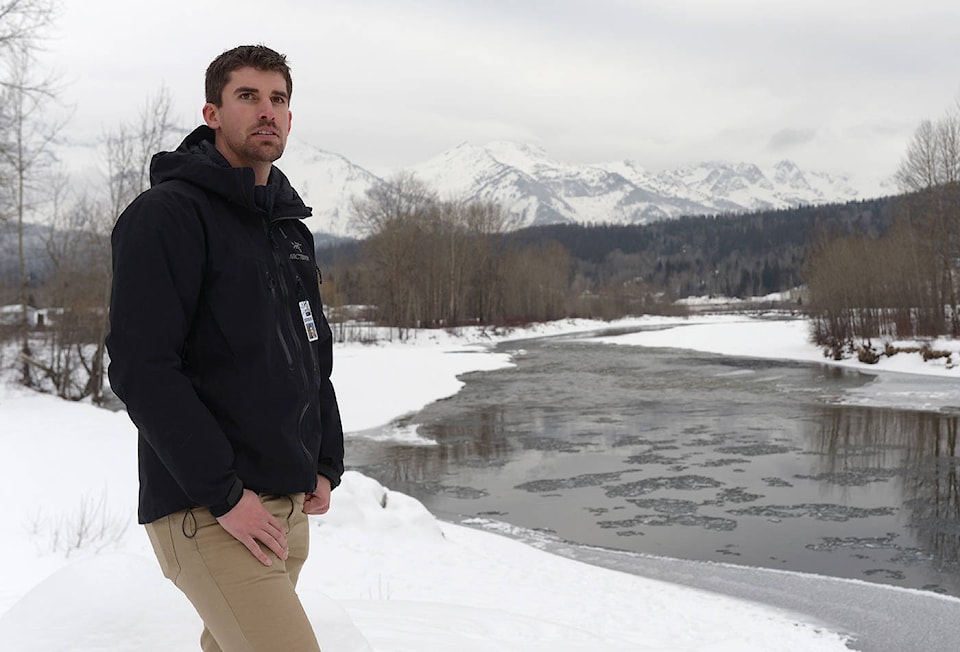According to an Elk Valley grizzly bear biologist, co-existing with grizzly bears is possible but will require major change.
Look back:
Grizzly bear biologist Clayton Lamb believes many locals may feel unheard, or hopeless in dealing with human-bear conflicts at home or in the bush. He says that the data-based evidence required to promote change is there, but it will require everyone to work together as a community to help fix the issue.
Lamb’s comments come after a spike in grizzly bear conflicts in Jaffray prompted a public meeting attended by close to 200 people this month. In 2018, there were 38 calls out of Jaffray regarding bear conflicts, as compared to almost no calls in 2017.
Lamb believes change comes in a variety of forms; from managing rural attractants in backyards and road densities, and stopping the use of carcass pits. That being said, he believes that the continued use of carcass pits in the South Country is driving this increase in bear traffic.
The current method of roadkill disposal is to dump the carcasses in designated pits. The Ministry of Transport allows highway contractor Mainroad to dispose of roadkill in this manner.
There are at least four active bonepits in the Elk Valley; the first just outside Jaffray, Tunnel Pit (near Tunnel Creek), Brule Pit (between Sparwood and Elkford) and Fir Creek (near the Corbin turnoff).
In addition to the ministry allowing the disposal of roadkill in the Jaffray bonepit, Lamb explained that hunters and ranchers also dump remains there.
Year round, carcasses are dropped at several pits around the Valley, one of which is close to Jaffray and residential properties. Tracking data collected by scientists shows grizzly bears using those pits and sleeping near them as well.
“What we’re seeing is that the bears are completely collapsing their home ranges on these carcass pits,” said Lamb.
“They’re getting served up a whole elk every couple of days and we’ll see upwards of eight or nine grizzly bears using a single pit at any time.”
The biologist explained that other jurisdictions in the Elk Valley saw the exact opposite trend in grizzly bear conflicts last year, with Elkford decreasing from about 25 calls in 2017 to less than five reports in 2018.
“The pattern has completely flipped in Elkford,” said Lamb.
“They had intense conflict in 2017 and almost none last year. And in Sparwood, their conflict calls halved.”
Lamb explained that a few bears can move from town to town and cause conflict as they go. He further explained that three or four, but not dozens of bears were the cause for many of the 38 calls reported in Jaffray last year.
The Kokanee salmon spawn could also be to blame for the increase in Jaffray bear calls last year. One of the largest salmon spawns in the area is located within Jaffray town limits.
This has been a long-standing problem since the 1970s when Kokanee salmon were accidentally introduced into Lake Koocanusa.
Lamb explained that this issue is hard for authorities to manage as compared to the carcass pits, which is a solvable issue. He suggested that a possible solution to the salmon problem could lie in allowing more liberal harvesting.
Although the population of grizzly bears in the Elk Valley is robust, these conflicts with humans contribute to the very low bear survival rate in the Valley and previously documented population declines.
“Grizzly bears in the Elk Valley have some of the lowest survival rates in all of North America due to many sources of mortality,” said Lamb.
“They have conflict in town, we have a major railway that runs through town, a highway, conflict in backcountry hunting camps and things like that.”
Lamb is a PhD Candidate with the South Rockies Grizzly Bear Project, and one member of a team of biologists that has been studying the population of grizzly bears in the Elk Valley for the past 11 years.
The team saw the local population of grizzly bears decline from 2006 to 2013 and have since watched it rebound.
Numbers are not yet at pre-2006 levels but are slowly increasing. Lamb said good berry crops in the past six years have contributed to this increase.
He and his colleagues will continue to monitor grizzly bears in the Valley, and Lamb hopes that the evidence they have gathered about the carcass pits will help spur on a change.
Lamb said this would be a win-win for both wildlife and the people in the Elk Valley.
According to Lamb, the Regional District of East Kootenay is currently reviewing their waste management plan and one of their options is to introduce a community composting system. This would allow the ministry, as well as hunters and ranchers, to dispose of carcasses in a way that would not attract wildlife.
“This could yield gains for people and wildlife,” said Lamb.
“Getting those carcasses off the landscape should improve human and bear safety.
“I think that keeping people safe and keeping bears further away from people would be something a lot of people in the Valley would get behind – regardless of where you stand on wildlife management.”
editor@thefreepress.ca
Like us on Facebook and follow us on Twitter



